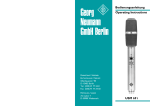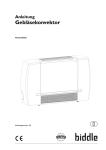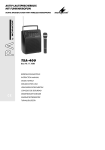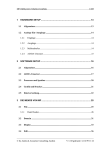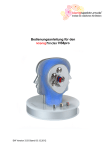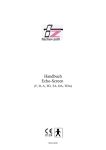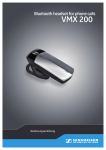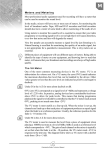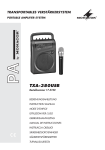Download Neumann.Berlin Dummy Head KU 100 User's Manual
Transcript
Betriebsanleitung Operating Instructions Ollenhauerstr. 98 13403 Berlin Germany Tel.: +49-30 / 417724-0 Fax: +49-30 / 417724-50 Email: [email protected] Web: www.neumann.com KU 100 Inhaltsverzeichnis Table of Contents 1. Kurzbeschreibung 1. Overview 2. Der Kunstkopf KU 100 2. The KU 100 Dummy Head 2.1 Wirkungsweise und Anwendung 2.1 Principles of Operation and Applications 2.2 Die Mikrophonausgänge 2.2 Microphone Outputs 2.2.1 Der symmetrische Ausgang 2.1.1 Balanced Output 2.2.2 Die unsymmetrischen Ausgänge 2.2.2 Unbalanced Outputs 2.3 Das Öffnen des Kunstkopfes 2.3 The Opening of the Dummy Head 2.4 Das schaltbare Hochpaßfilter, der –10 dB-Schalter 2.4 Switchable High-Pass Filter, –10 dB Switch 2.5 Mikrophonkabel 2.5 Microphone Cables 3. Stromversorgung 3. Power Supply 3.1 Batteriespeisung 3.1 Battery Operation 3.2 Betrieb mit externem Netzgerät 3.2 Operation with External Power Supply Unit 3.3 Phantomspeisung 3.3 Phantom Powering 4. Frequenzgänge 4. Frequency Responses 4.1 Freifeldfrequenzgang 4.1 Free-field Frequency Response 4.2 Diffusfeldfrequenzgang 4.2 Diffuse-field Frequency Responses 4.3 Terzpegel der Eigenstörspannung 4.3 Third-Octave Self Noise Level 5. Technische Daten KU 100 5. KU 100 Technical Specifications 6. Das Kalibrieren der Kunstkopfsysteme 6. Calibrating the Dummy Head Systems 7. Servicehinweise 7. Service 8. Zubehör 8. Accessories 2 1. Kurzbeschreibung 1. Overview Der Kunstkopf KU 100 ist in seinen Abmessungen dem menschlichen Kopf nachgebildet und in den Ohren mit Mikrophonen ausgerüstet. The KU 100 dummy head is a replication of the human head, equipped with microphones within the “ears”. Listening to recordings made with this system through high-quality, diffuse-field equalized headphones or analyzing the acoustic data gathered by the system affords a “listening” impression which dimensionally recreates the acoustical information present at the location of the head during the original acoustical “event” (i.e. ‘Head-Related Stereophony’). Zum Abhören der Kunstkopfsignale sollten hochwertige, diffusfeldentzerrte Kopfhörer verwendet werden. Dann gewinnt man den Eindruck des Dabeiseins am Ort der Darbietung („Kopfbezogene Stereophonie“). Das Klangbild bei Lautsprecherwiedergabe entspricht weitgehend dem eines herkömmlichen Stereomikrophons, jedoch mit differenzierterer Abbildung der Raumtiefe. lf reproduced through loudspeakers, the sound impressions are almost identical to those obtained by means of conventional stereo microphone techniques with an increased sense of “depth” of the soundstage. Aufgrund seiner Bauweise eignet sich der Kunstkopf als Aufnahmesystem und Meßmittel vor allem für folgende Aufgaben: Thanks to its design, the dummy head is a suitable means of recording and monitoring for a number of applications, in particular: • Hörspiel/Featureproduktionen • Radio Drama/Feature Productions • Konzertmitschnitte und Live-Übertragungen aus den Bereichen Klassik, Jazz, Pop und Unterhaltung • Recording of concerts and live broadcasts in the areas of classical music, jazz, pop music, and entertainment shows • Stereoaufnahmen ohne großen Aufwand in akustisch sehr komplexen Räumen – z. B. in Kirchen • Stereo recordings with relatively simple means in acoustically very complex environments (i.e. churches, etc.) • Dokumentation von Tierstimmen und Naturbildern, von Konferenzen, Theater- und Opernaufführungen • Documentation of animal voices and natural sounds, conferences, theater and opera performances • Einspielkontrolle in Sälen, Theatern und Auditorien • Monitoring of the effect of P.A. Systems in halls, theaters, and auditoriums • Dokumentation und Beurteilung der Hörsamkeit von Räumen wie z. B. Konzertsälen • Documentation and assessment of the audibility conditions of rooms (i.e. concert halls) • Dokumentation und Beurteilung von Musikinstrumenten • Documentation and assessment of musical instruments • Dokumentation und Beurteilung einer elektroakustischen Übertragungsanlage in Räumen oder auch in Fahrzeugen (Kommunikationsanlagen, Autolautsprecher) • Documentation and assessment of electroacoustic P.A. Systems in rooms and/or in automobiles (i.e. evaluation of automotive loudspeakers) • Sprachverständlichkeitsmessungen • Measurement of speech intelligibility • Dokumentation und Beurteilung der Belästigung durch Lärm in der Industrie, am Arbeitsplatz und im Verkehr • Documentation and assessment of noise nuisance in industry, at workplaces or in traffic • Messung von (offenen) Kopfhörern • Measurement of (open) headphones The dummy head is provided with balanced and unbalanced, transformerless outputs. Der Kunstkopf besitzt symmetrische und unsymmetrische transformatorlose Ausgänge. 3 Der symmetrische Ausgang Balanced output 5-poliger XLR-Stecker: 5-pin XLR connector, pin assignment: 0 V, Masse Pin 1: 0 V, ground Stift 2 (+): Stift 3: Modulation linker Kanal Pin 2 (+): Pin 3: modulation left channel Stift 4 (+): Stift 5: Modulation rechter Kanal Pin 4 (+): Pin 5: modulation right channel Stift 1: Über diesen symmetrischen Ausgang kann der Kunstkopf KU 100 mit 48 V, 3,5 mA pro Kanal phantomgespeist werden (DIN EN 60268-12 bzw. IEC 60268-12). Es müssen stets beide Kanäle gespeist werden. This balanced output also permits phantom powering of the KU 100 dummy head with dual 48 V, 3.5 mA (DIN EN 60268-12 and/or IEC 60268-12). Both channels always have to be powered. Der Anschluß erfolgt über das beigelegte 5-adrige Kabel IC 5, das mit Hilfe des ebenfalls mitgelieferten Adapterkabels AC 20 auf zwei 3-polige XLR-Stecker aufgelöst werden kann. The KU 100 dummy head is connected by means of the 5-pin IC 5 cable (supplied) which can be distributed to two 3-pin XLR connectors by means of the AC 20 adapter cable (supplied as well). Kabelfarbe gelb: linker Kanal, Kabelfarbe rot: rechter Kanal. Yellow cable: left channel, red cable: right channel. Steckerbelegung: Connector pin assignment: Stift 1: 0 V, Masse Pin 1: 0 V, ground Stift 2 (+): Stift 3: Modulation für symmetrische Eingänge Pin 2 (+): Pin 3: modulation for balanced inputs Der unsymmetrische Ausgang Unbalanced output BNC-Buchse L für den linken Kanal und BNC-Buchse R für den rechten Kanal. Female BNC connector L for left channel and BNC connector R for right channel. Bei Verwendung dieser Ausgänge wird der Kunstkopf KU 100 entweder intern mit Batterien oder extern mit dem beiliegenden Steckernetzteil gespeist. When these outputs are used the KU 100 dummy head is powered either via internal batteries or via the external power supply unit. Stromversorgung Power Supply Wahl der Stromversorgung mit dem Kippschalter neben dem 5-poligen XLR-Ausgang: Power supply adjustment by means of the flip switch beside the 5-pin XLR output: „P48“ für Phantomspeisung über den symmetrischen Ausgang des Kunstkopfes “P48” for phantom powering via the balanced output of the dummy head „BATT.“ für Speisung durch 6 Batterien LR 6, Größe AA im Kunstkopf “BATT.” for powering via six LR 6 batteries, size AA, within the dummy head „EXT.“ für Speisung über das mitgelieferte Steckernetzteil, anzuschließen an dem 2-poligen Einbaustekker „EXT.“ “EXT.” for powering via the power supply unit supplied, to be connected to the 2-pin male connector “EXT. ” Etwa 10 s nach dem Anschalten ist der Kunstkopf betriebsbereit. The dummy head is ready for operation approx. 10 seconds after power-up. Zum Einlegen der Batterien den Kunstkopf mit den beiden Vierteldrehverschlüssen am Hinterkopf entriegeln und auseinanderziehen. Dann wird ein Batteriegehäuse für sechs Batterien des Typs LR 6, Größe AA („Mignon“) zugänglich. In order to install the batteries, unlock the dummy head at the two 90° lock fasteners at the back of the head, and pull the two halves apart. The battery box for six batteries, type LR 6, size AA (round cells) is then accessible. (+) positiver Spannungsanstieg bei einem Schalldruckanstieg vor dem jeweiligen Ohr (+) polarity at a sudden rise of sound pressure in front of the respective ear 4 Mit hochwertigen Alkali-Mangan-Batterien ist ein Dauerbetrieb von mindestens 15 Stunden möglich. Etwa eine Stunde, bevor die Batterien die Stromversorgung nicht mehr sicherstellen können, beginnt die rote Leuchtdiode „Low Batt.“ zu blinken. Die Leuchtdiode blinkt auch beim Einschalten kurz auf, bleibt aber bei ausreichender Batteriekapazität während des Betriebs dunkel. High-quality alkali-manganese batteries permit continuous operation of at least 15 hours. The red LED “Low Batt.” starts flashing approx. one hour before the battery power supply will fail. The LED also flashes briefly during power-up, but remains dark subsequently as long as the battery capacity is sufficient. Bei geöffnetem Kopf werden auch die internen Kippschalter zugänglich: The internal flip switches are also accessible after opening of the dummy head: • Der schaltbare Hochpaß 150 Hz, 40 Hz und Linear • switchable high-pass filter 150 Hz, 40 Hz, and linear • Die schaltbare 10 dB-Dämpfung der Empfindlichkeit • switchable 10 dB attenuation 5 2. Der Kunstkopf KU 100 2. KU 100 Dummy Head 2.1 Wirkungsweise und Anwendung 2.1 Principles of Operation and Applications Der Kunstkopf KU 100 ist in seinen Abmessungen dem menschlichen Kopf nachgebildet und anstelle der beiden Gehörorgane mit Mikrophonen ausgerüstet. Beim Abhören des Kunstkopfsignals mit einem hochwertigen, diffusfeldentzerrten Kopfhörer entsteht ein Höreindruck, der fast vollständig demjenigen gleicht, den der Hörer bei stillgehaltenem Kopf am Ort des Kunstkopfes gewinnen würde und vermittelt daher die Illusion des Dabeiseins am Ort der Darbietung. The KU 100 dummy head is a replica dimensionwise of the human head, equipped with microphones in place of the ears. Listening to the dummy head signals through high-quality, diffuse-field equalized headphones, the listener receives an impression which is almost completely identical to that which he or she would have when keeping the head stationary at the location of the dummy head, i.e. the illusion of physical presence at the scene of the performance. Das Klangbild bei Lautsprecherwiedergabe entspricht weitgehend dem, das ein herkömmliches Stereomikrophon am Ort des Kunstkopfes übertragen würde, jedoch mit differenzierterer Abbildung der Raumtiefe. lf reproduced through loudspeakers, the sound impressions are almost identical to those obtained by means of conventional stereo microphone techniques with an increased sense of “depth” of the soundstage. Für kreative Hörspielgestaltung ist der Kunstkopf ebenso gut geeignet wie beispielweise für Musikaufnahmen, wobei der Vorteil gegenüber herkömmlicher Aufnahmetechnik in der getreuen Übertragung der Raumakustik liegt. Der KU 100 wird aber auch zur Untersuchung von Lärmeinflüssen an verschiedensten Arbeitsplätzen unter wirklichkeitsgetreuen Bedingungen eingesetzt. Dabei wird das Schallfeld physiologisch richtig erfaßt, kann aufgezeichnet und bei Bedarf erst später – evtl. von mehreren Versuchspersonen unter denselben Hörbedingungen – ausgewertet werden. For artistic recordings, the KU 100 is equally suited for creative radio drama recordings and for music presentations, the advantage of the KU 100 over conventional stereo recording techniques being a more realistic representation of the acoustic conditions in the recording environment. In industrial applications, the KU 100 can be utilized to assess noise influences at different workplaces under realistic conditions. The sound field is received in a physiologically proper manner and can be recorded for subsequent evaluation by different test subjects under the same listening conditions. Der KU 100 stellt bereits die dritte Generation des Neumann-Kunstkopfes dar. Während der Schritt vom ersten Studio-Kunstkopf, dem KU 80, zum KU 81 der Übergang von der Freifeldentzerrung zur Diffusfeldentzerrung war und damit die Lautsprecherkompatibilität der Kunstkopfsignale sicherstellte, werden im Kunstkopf KU 100 folgende technische Verbesserungen angeboten: The KU 100 represents the third generation of the Neumann artificial head stereo microphone systems (dummy head). The original KU 80 was replaced by the KU 81 which marked the transition from “freefield” equalization to “diffuse-field” equalization. This yielded compatibility of the dummy head signals with stereo loudspeaker reproduction. The KU 100 replaces the KU 81 and offers the following advancements: Akustische Verbesserungen Acoustic lmprovements • Überarbeitung der Außenohren für exakte Symmetrie der Charakteristika links/rechts • Revised design of the outer ears for precise symmetry of the left/right characteristics • noch bessere Annäherung an das Ideal „ebener Diffusfeldfrequenzgang“ • Improved approximation of the ideal “smooth diffuse-field frequency response” • Korrektur der Ohrkoordinaten zur Vermeidung einer Elevation der Schallquellen im Hörereignis • Adjusted ear coordinates, thereby avoiding vertical displacements of sound sources (artificial elevations) in the listening event 6 Schaltungstechnische Verbesserungen Improved Circuitry • Transformatorlose Schaltungstechnik „fet 100“ • Transformerless “fet 100” circuit • Erhöhung des Übertragungsmaßes um 5 dB • Sensitivity increased by 5 dB • Erweiterung des Dynamikumfangs um 5 dB • Dynamic range increased by 5 dB Verbesserte Handhabung Improved Flexibility • • • Mehrfache Stromversorgungsmöglichkeit: Flexible power supply configurations: – Eingebaute Batteriespeisung mit KontrollLED „Low Batt.“ – Integrated battery supply with LED “low battery power” – externe Phantomspeisung P48 durch 5-poligen XLR-Stecker – external P48 phantom powering via 5-pin XLR connection – Versorgung aus mitgeliefertem Steckernetzgerät möglich – powering via supplied external power supply unit Alternative Ausgangsbeschaltung: – • Symmetrische XLR-Ausgänge für Studiobetrieb und getrennte links/rechts BNC-Ausgänge für unsymmetrische Meß-, Daten-und Speichergeräte eingebaut Flexible output connector configurations: – Integrated, balanced XLR outputs for studiooperation as well as separate Left/Right BNC outputs for unbalanced measuring, data processing and data storage devices • Schaltbares Hochpaßfilter (150 Hz, 40 Hz und Linear) • Switchable high-pass filter (150 Hz, 40 Hz and linear) • Schaltbare 10 dB-Dämpfung • Switchable 10 dB attenuation Gerade wegen der aufgeführten Verbesserungen haben die grundsätzlichen Veröffentlichungen über das Arbeiten mit dem Kunstkopf, die in der beiliegenden Dokumentation zusammengestellt sind, weiterhin Gültigkeit. Especially because of the above-mentioned improvements, the general publications concerning the use of the dummy head, which are compiled in the enclosed documentation, remain in full effect. Sie sollen zeigen, wo der Kunstkopf als Aufnahmesystem und Meßmittel bisher mit Erfolg eingesetzt wurde und warum er sich für die im folgenden aufgeführten Aufgaben z.T. besser eignet als „normale“ Stereomikrophonanordnungen oder Meßmikrophone: Their purpose is to describe applications in which the dummy head as a recording system and measuring instrument has been successfully used so far, and why it is sometimes more suitable than “normal” stereo microphone arrangements or measuring microphones for the applications described below: • Hörspiel/Featureproduktionen • Radio Drama/Feature Productions • Konzertmitschnitte und Live-Ubertragungen aus den Bereichen Klassik, Jazz, Pop und Unterhaltung • Recording of concerts and live broadcasts in the areas of classical music, jazz, pop music, and entertainment shows • Stereoaufnahmen ohne großen Aufwand in akustisch sehr komplexen Räumen – z.B. in Kirchen • Stereo recordings with relatively simple means in acoustically very complex environments (i.e. churches, etc.) • Dokumentation von Tierstimmen und Naturbildern, von Konferenzen, Theater- und Opernaufführungen • Documentation of animal voices and natural sounds, conferences, theater and opera performances • Einspielkontrolle in Sälen, Theatern und Auditorien • Monitoring of the effect of P.A. Systems in halls, theaters, and auditoriums 7 • Dokumentation und Beurteilung der Hörsamkeit von Räumen wie z.B. KonzertsäIen • Documentation and assessment of the audibility conditions of rooms (i.e. concert halls) • Dokumentation und Beurteilung von Musikinstrumenten • Documentation and assessment of musical instruments • Dokumentation und Beurteilung einer elektroakustischen Übertragungsanlage in Räumen oder auch in Fahrzeugen (Kommunikationsanlagen, Autolautsprecher) • Documentation and assessment of electroacoustic P.A. Systems in rooms and/or in automobiles (i.e. evaluation of automotive loudspeakers) • Sprachverständlichkeitsmessungen • Measurement of speech intelligibility • Dokumentation und Beurteilung der Belästigung durch Lärm in der Industrie, am Arbeitsplatz und im Verkehr • Documentation and assessment of noise nuisance in industry, at workplaces or in traffic • Messung von (offenen) Kopfhörern • Measurement of (open) headphones Der Kunstkopf ist das Anfangsglied einer Übertragungskette in „Kopfbezogener Stereophonie“. Am anderen Ende sollten hochwertige diffusfeldentzerrte Kopfhörer stehen. Deshalb wird in der beiliegenden Literaturauswahl auch auf die optimale Kopfhörerentzerrung bzw. auf entsprechend konstruierte Kopfhörer eingegangen. The dummy head is the first link of the transmission chain in “Head-Related Stereophony”. High-quality, diffuse-field equalized headphones should be on the other end. This is why the enclosed literature also refers to the subject of optimal headphone equalization as well as suitable designed headphones. 2.2 Die Mikrophonausgänge 2.2 Microphone Outputs Der Kunstkopf KU 100 besitzt symmetrische und unsymmetrische transformatorlose Ausgänge. The KU 100 dummy head is provided with balanced and unbalanced, transformerless outputs. 2.2.1 2.2.1 Balanced Output Der symmetrische Ausgang The balanced 5-pin XLR output features the following circuitry according to DIN EN 60268-12 and/or IEC 60268-12: Der symmetrische 5-polige XLR-Ausgang hat folgende Beschaltung gemäß DIN EN 60268-12 bzw. IEC 60268-12: 0 V, Masse Pin 1: 0 V, ground Stift 2 (+): Stift 3: Modulation linker Kanal Pin 2 (+): Pin 3: modulation left channel Stift 4 (+): Stift 5: Modulation rechter Kanal Pin 4 (+): Pin 5: modulation right channel Stift 1: Über diesen symmetrischen Ausgang kann der Kunstkopf KU 100 mit 48 V, 3,5 mA pro Kanal phantomgespeist werden (s. Kapitel 3.3 „Phantomspeisung“). This balanced output also permits phantom powering of the KU 100 dummy head with 48 V, 3.5 mA, each channel, (see chapter 3.3: “Phantom, powering”). Es muß beachtet werden, daß an diesem Ausgang auch bei Speisung aus Batterien oder aus dem externen Steckernetzgerät die 48 V-Phantomspeisung anliegt, die intern erzeugt wird. Note that the 48 V phantom power, which is generated internally, is present at the output even if power is obtained via the internal batteries or via the external power supply unit. (+) positiver Spannungsanstieg bei einem Schalldruckanstieg vor dem jeweiligen Ohr (+) polarity at a sudden rise of sound pressure in front of the respective ear 8 Daher müssen spezielle Kabel verwendet werden, falls der XLR-Ausgang für unsymmetrische Eingänge benutzt werden soll (s. Kapitel 2.5 „ Mikrophonkabel“). Special cables are hence necessary if the XLR output has to be used for unbalanced inputs (see chapter 2.5: “Microphone cable”). Der 5-polige XLR-Ausgang kann mit Hilfe des zum Lieferumfang gehörigen Adapterkabels AC 20 auf zwei 3-polige XLR-Stecker aufgelöst werden und paßt dann auf in der Studiotechnik übliche (phantomgespeiste) Mikrophoneingänge (s. Kapitel 2.5 „Mikrophonkabel“). The 5-pin XLR output can be distributed to two 3-pin XLR connectors by means of the AC 20 adapter cable supplied and then matches the common (phantom-powered) microphone inputs for studio applications (see chapter 2.5: “Microphone cable”). 2.2.2 2.2.2 Unbalanced Outputs Die unsymmetrischen Ausgänge Für den Betrieb an unsymmetrischen Eingängen (DAT-Recorder, Meßgeräte etc.) stehen die Ausgangssignale gleichspannungsfrei an zwei BNC-Buchsen, beschriftet mit L für den linken Kanal und R für den rechten Kanal, zur Verfügung. The output signals are also available dc-free at two female BNC connectors (marked “L” and “R” for left and right respectively) for operation in conjunction with unbalanced inputs, (i.e. DAT recorders, measurement instruments, etc.). Bei Verwendung dieser Ausgänge wird der KU 100 entweder intern mit Batterien oder extern mit dem beiliegenden Steckernetzteil gespeist. Siehe dazu Kapitel 2.3 „Das Öffnen des Kunstkopfes“, Kapitel 3.1 „Batteriespeisung“ und Kapitel 3.2 „Betrieb mit externem Netzgerät. When the engineer is utilizing the unbalanced outputs, the required phantom power can be obtained either via internal batteries or via the external power supply. See chapter 2.3: “Opening the dummy head”, chapter 3.1: “Battery supply”, and chapter 3.2: “Operation with external power supply unit“. Durch spezielle Adapterkabel (separat lieferbares Zubehör) kann der Kunstkopf auch unter Verwendung des 5-poligen XLR-Ausgangs auf unsymmetrische Klinkeneingänge geschaltet werden. Siehe Kapitel 2.5 „Mikrophonkabel“. By means of special adapter cables (separately available accessories) the dummy head can also be connected to unbalanced jack-plug inputs. See chapter 2.5: “Microphone Cables”. 2.3 Das Öffnen des Kunstkopfes 2.3 Opening the Dummy Head Zum Einlegen bzw. Austauschen von Batterien bei netzunabhängiger Speisung, zum Bedienen des schaltbaren Hochpaßfilters oder der 10 dB-Dämpfung oder für eventuelle Reparaturarbeiten muß der Kunstkopf geöffnet werden. The KU 100 dummy head can be opened to access the batteries for mains-independent power supply, to operate the switchable high-pass filter or the 10 dB attenuation unit, or whenever any service work has to be done. Dieses geschieht mit Hilfe der beiden Vierteldrehverschlüsse am Hinterkopf. Sie werden durch jeweils eine Viertel-Linksdrehung entriegelt. Dann kann die hintere Kopfhälfte (ohne Ohren) parallel nach hinten abgezogen werden, während die vordere Kopfhälfte z.B. auf dem Stativ etc. verbleiben kann. This is done by means of the two 90° lock fasteners at the back of the head which are unlocked by turning them counter-clockwise. The back of the head (without the ears) can then be pulled off leaving the front which can be left in place, e.g. on a microphone stand. Nach dem Öffnen des Kunstkopfes werden die Batteriehalterung, die Ohrsysteme und das Gehäuse der Ausgangsstufe sichtbar. The battery holder, the ear systems, and the output stage are visible after opening the dummy head. Der Zusammenbau erfolgt sinngemäß umgekehrt durch Aufschieben des Hinterkopfes mit anschließendem Verriegeln durch Rechtsdrehung der beiden Vierteldrehverschlüsse, bis die Knäufe waagerecht positioniert sind. For reassembly, proceed in inverse order: first fix the back of the head in place and lock by turning the lock fasteners until the knobs are in a horizontal position. 9 2.4 Das schaltbare Hochpaßfilter, der –10 dB-Schalter 2.4 Switchable High-Pass Filter, –10 dB Switch Nach dem Öffnen des Kunstkopfes (s. Kapitel 2.3) werden an der Oberseite der Ausgangsstufe zwei Kippschalter zugänglich: After opening the dummy head, (see chapter 2.3) two flip switches are accessible on top of the output stage: Links der 3-stufige Schalter für verschiedene Grenzfrequenzen eines Hochpaßfilters, rechts der –10 dBSchalter zur Reduzierung des Übertragungsmaßes. On the left-hand side is a 3-position switch for different corner frequencies of a high-pass filter. The –10 dB pad switch is on the right. Beide Schalter wirken jeweils auf beide Kanäle. Each switch influences both channels. Die –3 dB-Grenzfrequenzen des Hochpaßfilters sind: The –3 dB corner frequencies of the high-pass filter are: 8 Hz in Schalterstellung LIN, 40 Hz und 150 Hz. Dadurch lassen sich tieffrequente Störungen wie z.B. Körperschall ausblenden. 8 Hz in the LIN position, 40 Hz, and 150 Hz. This feature permits elimination of low-frequency interferences, such as structure-borne noise. 2.5 Mikrophonkabel 2.5 Microphone Cable Der symmetrische Anschluß des Kunstkopfes KU 100 erfolgt über das beigelegte 5-polige geschirmte Mikrophonkabel IC 5. Balanced connection to the KU 100 dummy head is possible via the shielded, 5-conductor microphone cable IC 5 (supplied). Mit Hilfe des ebenfalls zum Lieferumfang gehörenden Adapterkabels AC 20 kann die 5-polige XLRArmatur auf zwei 3-polige XLR-Stecker aufgelöst werden und paßt dann auf in der Studiotechnik übliche (phantomgespeiste) Mikrophoneingänge. The 5-pin XLR fitting can be distributed to two 3-pin XLR connectors by means of the AC 20 adapter cable (supplied) and then matches the common (phantom-powered) microphone inputs for studio applications. Die Kabelfarbe gelb des Adapterkabels AC 20 bezeichnet den linken Kanal, die Farbe rot den rechten Kanal. The yellow cable of the AC 20 adapter cable is for the left channel, the red cable for the right channel. Die 3-poligen Stecker XLR 3 M sind entsprechend DIN EN 60268-12 bzw. IEC 60268-12 beschaltet: The 3-pin XLR 3 male connectors are wired according to DIN EN 60268-12 and/or IEC 60268-12: Jeweils Stift 1: 0 V, Gehäuse (Masse) Pin 1: 0 V, shield (ground) Stift 2 (+): Stift 3: Modulation für symmetrische Eingänge Pin 2 (+): Pin 3: modulation for balanced inputs Als separates Zubehör ist das Adapterkabel AC 29 lieferbar. Mit ihm kann der 5-polige XLR-Stecker des Kunstkopfes auf unsymmetrische Eingänge von z.B. DAT-Recordern adaptiert werden. The AC 29 adapter cable is available as separate accessory. It facilitates connection of the 5-pin XLR connector of the dummy head to unbalanced inputs, e.g. of DAT recoders. Das Kabel AC 29 führt die Modulation auf zwei 6,3 mm Ø Monoklinkenstecker. Das Kabel hat RCGlieder eingebaut, um die am 5-poligen XLR-Ausgang des KU 100 anstehende Gleichspannung abzublocken. The AC 29 cable routes the modulation to two mono 1/4" type jack-plug connectors, 6.3 mm. The cable is provided with integrated RC elements in order to ward off the dc voltage which is available at the 5-pin XLR output of the KU 100. (+) positiver Spannungsanstieg bei einem Schalldruckanstieg vor dem jeweiligen Ohr (+) polarity at a sudden rise of sound pressure in front of the respective ear 10 Eine Verlängerung des 5-poligen Kabels ist mit weiteren Kabeln vom Typ IC 5 (separates Zubehör) möglich. Standardlänge ist jeweils 10 m. The 5-pin cable can be extended by means of additional cables, type IC 5 (separate accessories). The standard length is 10 meters. Die 3-poligen XLR-Stecker des AC 20 können mit zwei 10 m langen Kabeln IC 3 (3-polig XLR, separates Zubehör) verlängert werden. The 3-pin XLR connectors of the AC 20 can be extended by means of two 10 meter IC 3 cables (3-pin XLR, separate accessories). Andere Kabellängen und/oder Kabelmaterial ohne Armaturen sind auf Wunsch lieferbar. Cables of different length and/or cables without fittings are available on request. Die akustischen Eigenschaften des Kunstkopfes werden auch durch sehr lange (Neumann-)Kabel nicht beeinflußt. Erst bei einer Kabellänge deutlich über 300 m macht sich ein Abfall im oberen Frequenzbereich bemerkbar. The acoustic properties of the dummy head are not affected by extra-Iong (Neumann) cables. lt is only with cable lengths well in excess of 300 meters that fall-off in the higher frequency range may become noticeable. 3. Stromversorgung 3. Power Supply Der Kunstkopf ist ca. 10 s nach dem Einschalten der Stromversorgung betriebsbereit. Er kann aus drei unterschiedlichen Quellen gespeist werden: The dummy head is ready for operation approx. 10 seconds after power-up. lt can be powered from three different sources: 3.1 Batteriespeisung 3.1 Battery Operation Zum Einlegen oder Auswechseln von Batterien muß der Kunstkopf geöffnet werden (s. Kap. 2.3). Im oberen Kopfteil befindet sich eine herausnehmbare Halterung für sechs Batterien vom Typ LR 67 Größe AA („Mignon“), je 1,5 V. Zu empfehlen ist die Verwendung hochwertiger Alkali-Mangan-Batterien, die aus Sicherheitsgründen während langer Betriebspausen aus dem KU 100 entfernt werden sollten. Dafür kann der Batterieanschluß (Druckknopfkontakte) abgezogen und die gesamte Halterung herausgenommen werden. The KU 100 can be powered by six batteries, type LR 6, size AA (“round cells”) of 1.5 V each. A removable holder is located in the upper portion of the head. See chapter 2.3 for information on accessing the battery section. We recommend the use of high-quality alkali-manganese batteries which should be removed from the KU 100 for safety reasons whenever it will not be used for prolonged periods. Removal of the complete battery holder is accomplished by pulling off the battery connections (snap contacts). Zur Batteriespeisung muß der Schalter an der Kopfunterseite auf „BATT.“ geschaltet sein. The switch at the bottom of the head must be set to “BATT.” for battery operation. Mit frischen Batterien ist ein Dauerbetrieb von mindestens 15 Stunden möglich 1) . New batteries will power the dummy head for at least 15 hours 1) . Etwa eine Stunde bevor die Batterien die Stromversorgung nicht mehr sicherstellen können, beginnt die rote Leuchtdiode „Low Batt.“, die sich am hinteren Halsansatz befindet, zu blinken. Die Leuchtdiode blinkt auch beim Einschalten kurz auf, bleibt dann aber bei ausreichender Batteriekapazität während des Betriebs dunkel. The red LED “Low Batt.” indicator at the neck starts flashing approx. one hour before the battery power supply will fail. 1) 1) The LED also flashes briefly during power-up, but remains dark subsequently as long as the battery capacity is sufficient. Bei Zimmertemperatur erhöht. Da die Kapazität von Batterien sehr temperaturabhängig ist, verändert sich die Betriebsdauer bei geringerer oder höherer Temperatur. 11 At normal room temperatures. The battery capacity will be significantly different with lower/higher ambient temperatures. 3.2 Betrieb mit externem Netzgerät 3.2 Operation with External Power Supply Unit Zum Betrieb des Kunstkopfes KU 100 mit dem zum Lieferumfang gehörenden Steckernetzgerät muß der Schalter an der Kopfunterseite auf „EXT.“ geschaltet werden. Das Steckernetzgerät wird mit dem 2-poligen Einbaustecker „EXT.“ verbunden und verschraubt. Operation of the KU 100 dummy head with the power supply unit supplied requires the switch at the bottom of the head to be set to “EXT.”. The power supply unit is connected to the integrated 2-pin “EXT.” connector and secured by means of a coupling ring. Diese Leitung kann mit einem Kabel CC 100 verlängert werden (separates Zubehör, Standardlänge 10 m). This cable can be extended with a CC 100 cable (separate accessory, standard length 10 meters). Der Kunstkopf wird mit 9 V, 60 mA Gleichstrom vom Steckernetzgerät gespeist. Der erlaubte Arbeitsbereich ist +7 V (70 mA) ... +26 V (20 mA). (Für Servicezwecke: der linke Pin des Einbausteckers ist bei Draufsicht von außen die Plusleitung, der rechte Pin ist 0 V, Masse. Im Gegenstecker ist die Plusleitung mit Pin 1 bezeichnet, Pin 2 ist 0 V, Masse). The dummy head requires a dc current of nominally 9 V, 60 mA. The permissible operating range is +7 V (70 mA) to +26 V (20 mA). (For service purposes: when seen from outside, the left pin of the integrated connector is the positive pole, the right pin being 0 V, ground. The positive pole of the mating connector is marked “Pin 1”, pin 2 being 0 V, ground). An die angelieferte Gleichspannung werden keine besonderen Anforderungen bezüglich Siebung gestellt. There are no particular filtering requirements concerning the dc voltage supplied. 3.3 Phantomspeisung 3.3 Phantom powering Über die symmetrischen Ausgänge des 5-poligen XLR-Steckers bzw. über die beiden 3-poligen XLRStecker des Adapterkabels AC 20 kann der Kunstkopf KU 100 phantomgespeist werden (P48, IEC 1938). Es müssen stets beide Kanäle mit 48 V, je 3,5 mA gespeist werden. Phantom powering of the KU 100 dummy head is possible (P48, IEC 1938) via the symmetrical outputs of the 5-pin XLR connectors and/or via the two 3pin XLR connectors of the AC 20 adapter cable. Both channels in any case require a supply of 48 V, 3.5 mA each. Bei der Phantomspeisung fließt der Speisestrom jeweils vom positiven Pol der Spannungsquelle (Mischpult oder Netzgerät) über die elektrische Mitte der beiden Modulationsadern zum Mikrophon. Er wird hierzu über zwei gleichgroße Widerstände bei den Tonadern gleichsinnig zugeführt. With phantom powering, the feeding current flows from the positive pole of the voltage source (mixing console or power supply unit), through the electrical center of the two modulation wires to the microphone. The supply current is fed into the two audio wires in the same direction via two identically resistors. Die Rückleitung des Gleichstroms erfolgt über den Kabelschirm. Zwischen beiden Modulationsadern besteht also keine Potentialdifferenz. The dc return is via the cable shield. This means that there is no difference in potentials between the two modulation wires. Für die Stromversorgung sind alle P48-Netzgeräte geeignet, die mindestens 3,5 mA je Kanal abgeben. Das entsprechende Neumann P48-Netzgerät hat die Bezeichnung N 48 i-2 i-2. Any P48 power supply unit supplying at least 3.5 mA per channel is suitable for power supply purposes. The corresponding Neumann P48 power supply unit is the model N 48 i-2 i-2. Die Zuordnung der Mikrophonanschlüsse und die Polarität der Modulationsadern ist am Ausgang der Speisegeräte die gleiche wie am Mikrophon. The assignment of the microphone connections and the polarity of the modulation wires are the same at the output of the power supply unit and at the microphone. 12 4. Frequenzgänge Frequency Responses Abbildung 1: Freifeldfrequenzgang unter 0° ( von vorn) Figure 1: Free-field frequency response 0° ( front) Abbildung 2: Diffusfeldfrequenzgang Figure 2: Diffuse-field frequency response 13 ± 2 dB ± 1 dB Abbildung 3: Terzpegel der Eigenstörspannung Figure 3: Third-Octave self noise level 14 5. KU 100 Technische Daten 5. KU 100 Technical Specifications 1 Pa = 10 µbar 0 dB 20 µPa 1 Pa = 10 µbar 0 dB 20 µPa Akustische Arbeitsweise ...................... Druckempfänger Acoustical oper. principle ............ Pressure transducer Richtcharakteristik .................................................................. Ohr Directional pattern .................................................................. Ear Übertragungsbereich ................................ 20 Hz ... 20 kHz Frequency range .......................................... 20 Hz ... 20 kHz Feldübertragungsfaktor1) Sensitivity 1) at 1 kHz .............................. 20 mV/Pa ± 1 dB bei 1 kHz ............................ 20 mV/Pa ± 1 dB –34 dBV –34 dBV Nennimpedanz symmetrischer Ausgang ........................................... 50 Ohm unsymmetrischer Ausgang .................................. 200 Ohm Rated impedance symmetrical output .................................................... 50 ohms unsymmetrical output ........................................... 200 ohms Nennabschlußimpedanz .................................... 1000 Ohm Rated load impedance ....................................... 1000 ohms Geräuschpegelabstand (bezogen auf 1 Pa bei 1 kHz, DIN 45 590 / DIN 45 405, CCIR 468-3) ......... 65 dB S/N ratio (related to 1 Pa at 1 kHz, (DIN 45 590 / DIN 45 405, CCIR 468-3) ........ 65 dB Ersatzgeräuschpegel (DIN 45 590 / DIN 45 405, CCIR 468-3) ........ 29 dB Equivalent noise level (DIN 45 590 / DIN 45 405, CCIR 468-3) ........ 29 dB A-bewerteter Äquivalentschalldruckpegel, bedingt durch innere Störquellen (DIN / IEC 651) .................................................................. 16 dB A-weighted equivalent SPL due to inherent noise (DIN/IEC 651) ...................................................................... 16 dB Grenzschalldruckpegel für 0,5 % Klirrfaktor2) ................................................. 135 dB 112 Pa Max. Ausgangsspannung dabei .............................................................................. 2 V 8 dBu Max. SPL for less than 0.5 % THD 2) ................................................. 135 dB 112 Pa maximal output voltage .......................................................................... 2 V 8 dBu Stromversorgung (alternativ) Power supply (alternative) Phantomspeisespannung (P48, IEC 1938) ...................................................... 48 V ± 4 V Phantom powering (P48, IEC 1938) .................................................... 48 V ± 4 V Stromaufnahme pro Kanal ........................................ 3,5 mA Current consumption per channel ..................... 3.5 mA Batteriespeisung ..................... 6 x 1,5V (AA), „Mignon“ Battery supply .................... 6 x 1.5 V (AA) “round cell” Externe Speisung mit Steckernetzteil (im Lieferumfang) .............................. 9 V, 60 mA External power supply unit (supplied) ................................................................... 9 V, 60 mA Gewicht KU 100 ohne Batterien ........................................ ca. 3500 g mit Tragekoffer ........................................................... ca. 9500 g Weight KU 100 without batteries ........................ approx. 3500 g with carrying case .......................................... approx. 9500 g Abmessungen KU 100 .................................................. 180 x 280 x 210 mm Tragekoffer (B x H x T) ............ 390 x 360 x 260 mm Dimensions KU 100 .................................................. 180 x 280 x 210 mm carrying case (W x H x D) ...... 390 x 360 x 260 mm 1) 2) 1) 2) bei 1 kHz an 1 kOhm Nennabschlußimpedanz. 1 Pa 94 dB SPL. Klirrfaktor des Mikrophonverstärkers bei einer Eingangsspannung, die der von der Kapsel beim entsprechenden Schalldruck abgegebenen Spannung entspricht. 15 at 1 kHz into 1 kOhm rated load impedance. 1 Pa 94 dB SPL. THD of microphone amplifier at an input voltage equivalent to the capsule output at the specified SPL. 6. Das Kalibrieren der Kunstkopfsysteme 6. Calibrating the Dummy Head Systems Die beiden Kunstkopfsysteme „Links“ und „Rechts“ können einzeln kalibriert werden. The two microphone systems on the “left” and on the “right” can be calibrated separately. Mit Hilfe eines Pistonphon-Adapters lassen sich Kalibratoren für 1"-Meßmikrophonkapseln (z.B. Bruel & Kjaer Typ 4230 oder Typ 4228) von außen in den jeweiligen Ohrkanalansatz stecken und beaufschlagen diesen mit einem definierten Schalldruckpegel. Dann kann entweder der Ausgangspegel nur des Kunstkopfes oder des gesamten Aufnahmesystems gemessen und notiert werden. A pistonphone adapter permits calibrators for 1" measuring microphone capsules (e.g. Bruel & Kjaer, type 4230 or type 4228) to be inserted from outside into the respective ear channel outlet. The calibrators then expose the microphone capsules to a defined sound pressure level. lt is then possible to measure and record the output level either of the dummy head only or of the entire recording system. 7. Servicehinweise 7. Service Information Zum normalen Gebrauch muß der Kunstkopf nur zum Einlegen bzw. zum Wechseln der Batterien oder zum Betätigen des Hochpaßfilters oder des Dämpfungsschalters geöffnet werden. Siehe dazu Kapitel 2.3. Opening of the dummy head is only required when installing or replacing the batteries or operating the high-pass filters or attenuation switch. See chapter 2.3. Für Servicearbeiten ist eventuell ein Öffnen auch des Ohrsystems und der Ausgangsstufe erforderlich. Service work may require also opening of the ear system and/or the output stage. Das Ohrsystem besteht aus den beiden Außenohren und dem zylindrischen Gehäuse zwischen den Ohren. Dieses ist jeweils neben den Außenohren im Vorderkopf eingeschnappt und kann komplett herausgehoben werden. The ear system consists of the two outer ears and the cylindrical enclosure between the ears. This enclosure is snap-fastened beside the outer ears in the front portion of the head and can be removed completely. Die Außenohren sind auf das zylindrische Gehäuse aufgeschnappt und lassen sich ohne Werkzeug abziehen. Dann werden die Ohradapter mit dem Ohrkanal frei. Sie können jeweils von den zylindrischen Gehäuserohren und diese ihrerseits vom mittleren Vierkant abgeschraubt werden, so daß die Platine mit den Impedanzwandlern (IC 101, IC 102) und Filterstufen zugänglich wird. The outer ears are snap-fastened on the cylindrical enclosure and can be pulled off without any additional tools. The ear adapters and the ear channels are then accessible. They can be detached from the cylindrical enclosure tubes which subsequently will unscrew from the central square, whereupon the board. with the impedance converters (IC 101, IC 102) and filter stages becomes accessible. Achtung: Note: Auf keinen Fall darf mit dem Finger auf die Gabelkontakte und auf die übrigen anderen hochohmigen Teile in diesem Bereich gefaßt werden, da geringste Schmutz und Fettrückstände die Isolation herabsetzen und Störspannungen verursachen können. You should never touch the forked contact at the face of the board with your fingers, nor should you touch the other extremely high-impedance parts in this area as even the slightest dirt and grease residues will reduce the insulation and cause noise. In den Ohradaptern befindet sich jeweils die Kondensator-Mikrophonkapsel und ein akustisches Anpaßfilter. Diese Ohradapter – obwohl aus mehreren Teilen zusammengesetzt – sollten als Einheit behandelt und im Falle eines Defekts komplett zur Reparatur ins Werk eingeschickt werden. Each ear adapter contains the condenser microphone capsule and an acoustic impedance transforming filter. Although these ear adapters consist of several parts, they should be treated as a unit and sent as such to the manufacturer if additional work is necessary. 16 Da beide Ohradapter im Werk auf gleiche Übertragungsmaße ausgesucht werden, ist darüberhinaus zu empfehlen, bei einem Defekt jeweils beide Ohradapter einzuschicken. Both ear adapters are carefully matched by the manufacturer in all relevant characteristics. Therefore both ear adapters should be returned to the factory whenever any repair work is necessary. Anstelle der Ohradapter läßt sich der Meßadapter MA 84/KU 100 auf die Gehäuserohre schrauben. Dann kann in den Meßadapter eine Modulationsspannung eingespeist und das gesamte System elektrisch überprüft werden, ohne einen akustischen Meßraum zu benötigen. The ear adapters can be replaced by the MA 84/ KU 100 test adapter. lt is then possible to feed a modulation voltage into the test adapter, so that the entire system can be checked electrically without the need to use an acoustic measuring room. Beim Zusammensetzen der Teile ist darauf zu achten, daß When assembling the parts, please ensure that: • die Kontaktstifte der Mikrophonkapseln korrekt in den jeweiligen Gabelkontakt an den Stirnseiten der Platine eingeführt werden, • the contact pins of the microphone capsules are properly inserted into the respective forked contact at the face of the board, • die richtigen Außenohren entsprechend der Gravur L, R (für links und rechts) auf dem Mittelteil auf die Ohradapter aufgeschnappt werden, • the proper outer ears are snapped onto the ear adapters as indicated by the marks L (left) and R (right) on the central part, • das Zuführungskabel im Stauraum unter dem zylindrischen Gehäuse verstaut wird und dafür der Kabelaustritt aus dem Vierkant-Mittelteil nach unten in den Stauraum zeigt, • the incoming cable is stored in the cable space below the cylindrical enclosure, with the cable outlet of the central square pointing downwards to the cable space, • das Anschlußkabel zur Batteriehalterung oberhalb des zylindrischen Gehäuses verläuft, damit der Batteriesatz bequem herausgenommen werden kann. • the connecting cable leading to the battery holder runs above the cylindrical enclosure, so that the batteries can be removed without any problems. Die Ohradapter sind für das linke und für das rechte Ohr identisch, sind also keinem Ohr besonders zugeordnet. Note: The ear adapters are identical for the left and right ears, i.e. not assigned to a particular ear. Das viereckige Gehäuse der Ausgangsstufe kann aus dem Vorderkopf herausgenommen werden, wenn die beiden Befestigungsschrauben entfernt worden sind. The square enclosure of the output stage can be removed from the front portion of the head after the two fixing screws have been removed. Um das Gehäuse zu öffnen, muß erst die obere Platte abgeschraubt und herausgehoben werden. Anschließend kann die untere Platte mit den Steckverbindern etc. abgeschraubt und mitsamt dem kompletten Innenaufbau vorsichtig herausgezogen werden. In order to open the enclosure, first remove the screws of the upper board (rear panel) and detach it. Thereafter, the lower board (front panel) including the plug connectors etc. can be unscrewed and pulled out carefully, together with the complete internal components. Wenn die Ohren und die Ohradapter vom Ohrsystem abgenommen sind, kann dieses durch das Gehäuse der Ausgangsstufe hindurchgeschoben werden. Es können aber auch die Anschlußleitungen zum Ohrsystem von der Ausgangsstufe abgezogen werden, wenn zuvor die Schelle zu deren Zugentlastung von der Platine abgeschraubt worden ist. After the ears and the ear adapters have been removed from the ear system, it can be pushed through the enclosure of the output stage. lt is, however, also possible to pull the connecting cables leading to the ear system off the output stage, if the tension relief clamp for the connecting cables has been taken off the board beforehand. 17 8. Zubehör 8. Accessories Zum mitgelieferten Zubehör gehört ein Steckernetzteil (siehe auch Kapitel 2.5 und Kapitel 3). Power supply unit (see chapter 2.5 and chapter 3) is included with the KU 100. Der Kunstkopf kann stehend oder hängend auf Stative oder Galgen montiert werden. Dafür sind oben und unten am Kopf 5/8"-27-Gang-Gewindeanschlüsse vorhanden. Reduziermuttern für 3/8''- und 1/2"-Gewindestutzen werden mitgeliefert. The dummy head can be installed on or suspended from microphone stands or booms. For this purpose, the head is provided with 5/8", 27-thread connections at its top and bottom. Reducing nuts for 3/8" and 1/2" threads are supplied with the system. IC 5 (10 m) ............................................................. Best.-Nr. 06623 IC 5 mt (10 m) ..................................................... Best.-Nr. 06624 (gehört zum Lieferumfang) 10 m langes Mikrophonkabel, Durchmesser 5 mm, mit Doppeldrallumspinnung als Abschirmung. 5-polige XLR-Steckverbinder. IC 5 (10 m) .............................................................. Cat. No. 06623 IC 5 mt (10 m) ...................................................... Cat. No. 06624 (included in the supply schedule) 10 m long microphone cable, 5 mm in diameter, with double twist braiding for screening. 5-pin XLR connectors. AC 20 (1 m) ........................................................... Best.-Nr. 06595 (gehört zum Lieferumfang) Y-Kabel mit einer 5-poligen XLR-Buchse und zwei 3-poligen XLR-Steckern, für die Verteilung von 2-kanaliger Modulation auf 2 Monokanäle, z. B. bei Verwendung des Speisegerätes BS 48 i-2. AC 20 (1 m) ............................................................ Cat. No. 06595 (included in the supply schedule) Y-cable with one 5-pin XLR connector and two 3-pin XLR connectors. It is used to split two-channel signals into two mono channels, when using, for example, the BS 48 i-2 power supply. AC 29 (0,3 m) ...................................................... Best.-Nr. 06604 Y-Kabel mit einer 5-poligen XLR-Buchse und zwei 6,3 mm Monoklinkensteckern, unsymmetrisch, mit Abblockung der Phantomspannung, für den 5-poligen XLR-Ausgang der Matrixbox MTX 191 (für MTX 191 A siehe AC 27) und KU 100 an Geräte mit 6,3 mm Monoklinkenbuchsen. AC 29 (0.3 m) ....................................................... Cat. No. 06604 Y-cable with a 5-pin XLR connector and two 6.3 mm monojacks, unbalanced, with blocking condensers. It is used to connect the 5-pin XLR output of the MTX 191 (MTX 191 A see AC 27) matrix amplifier and KU 100 microphone to units with 6.3 mm monojack inputs. MF 4 ........................................ sw ............................. Best.-Nr. 07337 Der Mikrophonfuß MF 4 ist ein Fußbodenständer aus Grauguß, ca. 2,6 kg schwer, Durchmesser 160 mm. Der Ständer ist schwarzmatt lackiert und steht gleitfest auf einem Gummiring. Ein umwendbarer Gewindezapfen und ein mitgeliefertes Reduzierstück ermöglichen die Verwendung für 1/2"- und 3/8"-Gewindeanschlüsse. MF 4 ........................................ blk .............................. Cat. No. 07337 Floor stand with grey cast iron base, 2.6 kg, 160 mm in diameter. The floor stand has a matt black finish and rests on a nonskid rubber disk attached to the bottom. A reversible stud and a reducer for 1/2" and 3/8" threads are also supplied. M 212 c ............................... sw/ni ....................... Best.-Nr. 07251 M 212 c ist ein Galgenaufsatz für den Fußbodenständer M 214/1. Gewicht 4,3 kg. Seitliche Ausladung variabel von 1,1 m bis 1,8 m, mit Gegengewicht für schwere Mikrophone. 3/8"-Gewindezapfen, 1/2"-Stativanschluß. Oberfläche teils vernickelt, teils schwarz lackiert. M 212 c ............................... blk/ni ....................... Cat.-No. 07251 M 212 c is a boom attachment designed for the floor stand M 214/1. Weight 4.3 kg. Boom extension is adjustable between 1.1 m and 1.8 m. Counterbalanced for heavy microphones; 3/8" threaded stud, 1/2" female thread. The boom is partly nickel-plated, partly black lacquered. M 214/1 ............................... sw/ni ....................... Best.-Nr. 07248 M 214/1 ist ein Fußbodenständer, klappbar, Gewicht 6 kg, sehr standfest durch ausladende Fußkonstruktion. Höhe variabel von 1,3 m bis 2,2 m, zusammengeklappt 1,2 m. Oberfläche teils vernickelt, teils M 214/1 ............................... blk/ni ....................... Cat.-No. 07248 M 214/1 is a folding floor stand, weight 6 kg, heavy duty. The height is adjustable between 1.3 and 2.2 m, when folded 1.2 m. The stand is partly nickel-plated, partly black lacquered. It has a 1/2" thread- 18 schwarz lackiert. 1/2"-Gewindezapfen für die Befestigung des Mikrophons oder des Galgenaufsatzes M 212 c. ed stud for mounting microphones or the M 212 c boom attachment. PA 100 .................................. sw ............................. Best.-Nr. 06199 Der Pistonphon-Adapter erlaubt das Einstecken eines Pistonphons für 1"-Meßmikrophone (z.B. Typ 4230 oder Typ 4228 der Firma Bruel & Kjaer) in jeweils einen Ohrkanal des Kunstkopfes KU 100. Damit kann jedes Ohrsystem einzeln kalibriert werden, ohne daß der Kunstkopf geöffnet werden muß (s. auch Kapitel 4.) PA 100 .................................. blk .............................. Cat. No. 06199 The pistonphone adapter permits inserting of a pistonphone for 1" measuring microphones (e.g. Bruel and Kjaer, type 4230 or type 4228) in each ear channel of the KU 100. Each ear system can hence be calibrated separately without opening the dummy head (see chapter 4). STV 4 ...................................... sw ............................. Best.-Nr. 06190 STV 20 ................................... sw ............................. Best.-Nr. 06187 STV 40 ................................... sw ............................. Best.-Nr. 06188 STV 60 ................................... sw ............................. Best.-Nr. 06189 Die Stativverlängerungen STV... werden zwischen Fußbodenständer und Mikrophonhalterung geschraubt. Dadurch entstehen unterschiedlich hohe Tisch- oder Fußbodenstative. STV 4 ...................................... blk .............................. Cat. No. 06190 STV 20 ................................... blk .............................. Cat. No. 06187 STV 40 ................................... blk .............................. Cat. No. 06188 STV 60 ................................... blk .............................. Cat. No. 06189 The STV... stand extensions are used between microphone and floor stands to provide table or floor stands of variable heights. Die STV... haben eine Länge von 40, 200, 400 oder 600 mm. Durchmesser: 19 mm. The STVs are 40, 200, 400 or 600 mm long. Diameter: 19 mm. WSB ........................................ sw ............................. Best.-Nr. 07372 Für Außenaufnahmen ist die Verwendung eines Windschutzes empfehlenswert. Der Windschutz WSB besteht aus zwei Formkörpern aus offenporigem Polyurethanschaum, die mit Hilfe eines Bügels wie Kopfhörer dem KU 100 aufgesetzt werden. Die Dämpfung des Windgeräusches beträgt ca. 15 dB. WSB ........................................ blk .............................. Cat. No. 07372 Use of a windscreen is recommended for outdoor recording. The WSB windscreen consists of two shells of polyurethane foam which can be attached to the KU 100 as would headphones. Wind noise is reduced by approx. 15 dB. 19 IC 5 AC 20 AC 29 MF 4 M 212 c M 214/1 PA 100 WSB STV... Irrtümer und technische Änderungen vorbehalten • Errors excepted, subject to changes Printed in Germany • Publ. 05/02 69413 / A 03
This document in other languages
- Deutsch: Neumann.Berlin Dummy Head KU 100




















